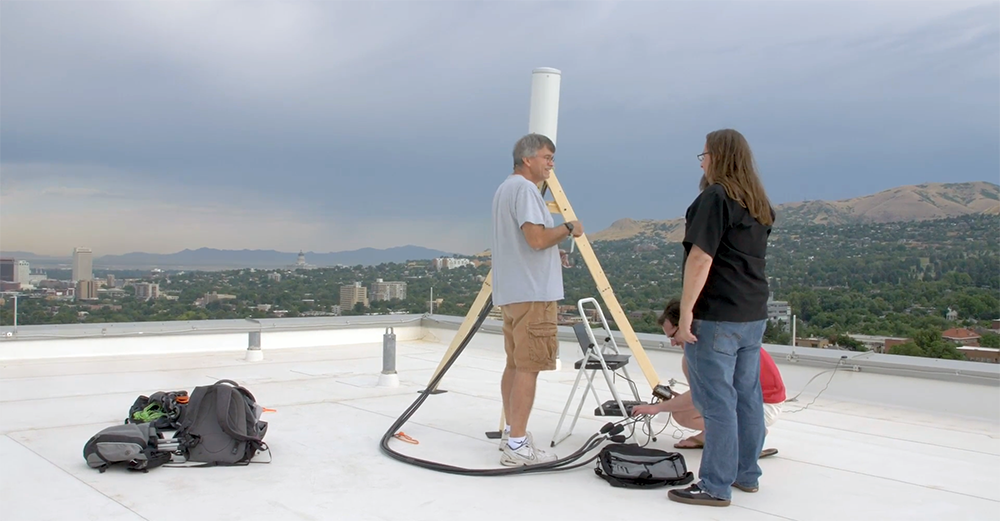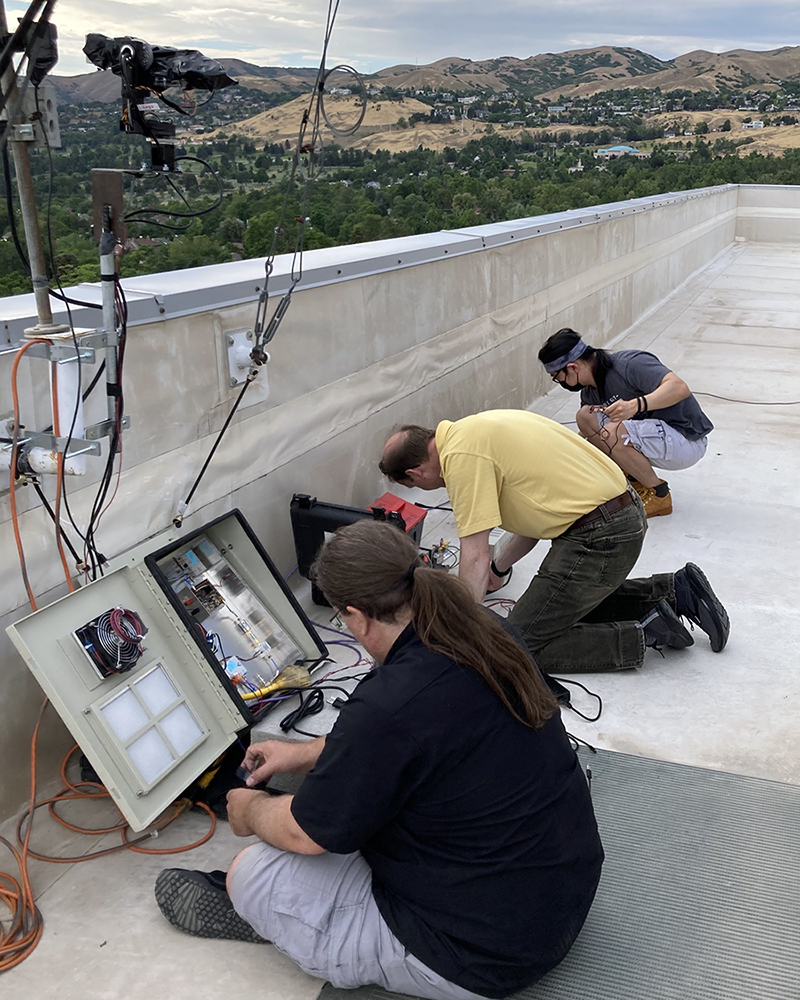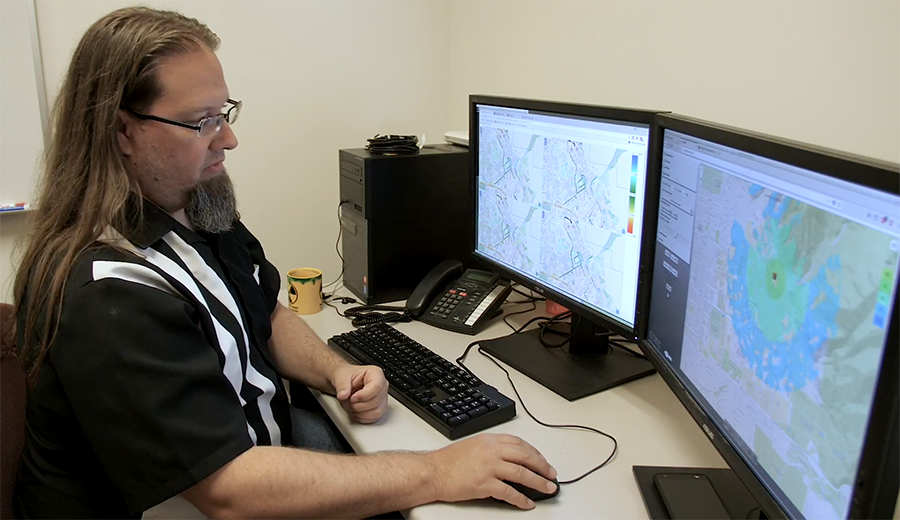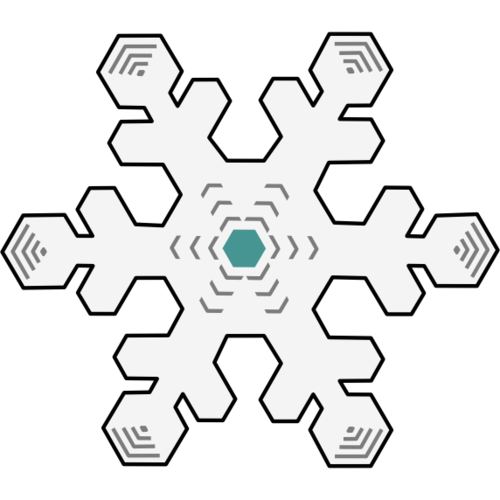You’re accessing archived content
This is archived content from the UIT website. Information may be outdated, and links may no longer function. Please contact stratcomm@it.utah.edu if you have any questions about archived content.
Turn to website and Twitter for POWDER news

Researchers on the roof of the Donna Garff Marriott Honors Residential Scholars Community are shown above in a screenshot from a video about the POWDER-RENEW project produced by the Utah Education and Telehealth Network (UETN).

Professor Chris Anderson of the U.S. Naval Academy and Ph.D. students Yaguang Zhang and Bharath Keshavamurthy (not pictured) from Purdue University collect millimeter-wave channel state measurements on the roof of the William Browning Building for a moving vehicle scenario.
The POWDER wireless testbed spearheaded by the University of Utah is such a sprawling endeavor, it can be daunting to stay on top of its many breakthroughs.
A good place to start for all things POWDER-related is powderwireless.net. The website’s “news room” page, much like the initiative itself, is constantly changing. Recent updates include a visit from a United States Naval Academy professor and Ph.D. students from Purdue University who used POWDER's bring-your-own-device capabilities to measure millimeter waves (mmWaves), frequency bands expected to fuel the 5G network revolution.
“The team regularly posts news items at the POWDER website so that users and others can stay up to date on the platform and learn more about how it’s being used,” said Dr. Eric Eide, research assistant professor in the U’s School of Computing.
Eide is part of POWDER’s leadership team at the U, a member of the partner Flux Research Group, and administrator of the Twitter page @powder_wireless, which he urges anyone interested in the initiative to follow to “keep tabs on the rapidly-emerging technologies under development.”
So what exactly is POWDER and why does it matter?

In the photo above, a 48-antenna Skylark mMIMO array sits alongside two 2-antenna clients inside an anechoic chamber within the Department of Electrical and Computer Engineering.
POWDER stands for the Platform for Open Wireless Data-driven Experimental Research. More than just a mouthful, it’s the federally-funded project creating a city-scale, remotely-accessible, end-to-end platform for research on mobile wireless networks, as well as applications and services that could run on top of advanced networks in the future. It provides radios that are programmable down to the waveform, attached to a network that can be configured by the user, and connected to a variety of compute, storage, and cloud resources.
Funded by the National Science Foundation and Platforms for Advanced Wireless Research (PAWR) program’s industry consortium, the platform is being built by the U in partnership with Salt Lake City and the Utah Education and Telehealth Network. In addition to off-the-shelf equipment, the POWDER team has been busy installing open-source software and hardware for the world’s first fully-programmable and observable wireless radio network developed by Rice University’s RENEW team.
POWDER matters because making major technological leaps from research to practice rely on large-scale testing.

Kirk Webb, associate director of the POWDER project and research associate in the School of Computing, discusses his role in this screenshot from a video produced by UETN.
Dr. Kobus Van der Merwe, POWDER’s principal investigator and an associate professor for the School of Computing, said the future of wireless networking requires researchers to build their own networks at scale, in real environments, “at all layers of the stack.” Stack in this case refers to a hierarchy of software layers in each network client and server, a layered approach that allows different protocols to be swapped in and out to accommodate various network architectures.
The “living laboratory” will ultimately span more than 6 miles of Salt Lake City — the downtown area, U campus, and a residential neighborhood — all overseen by academic researchers and private industry and government partners.
This layout presents a rich environment to perform real experiments. Each location presents a unique topographic challenge, from the looming presence of the Wasatch mountains to various terrain types, building sizes, and densities. A POWDER subproject, for example, involves testing 5G wireless networks using programmable cell towers on campus and other points downtown.
“Groundbreaking wireless technologies are being tested in Salt Lake City and simultaneously at partner sites across the country,” Van der Merwe said. “It’s an exciting time.”

Additional resources:
Node 4
Our monthly newsletter includes news from UIT and other campus/ University of Utah Health IT organizations, features about UIT employees, IT governance news, and various announcements and updates.
